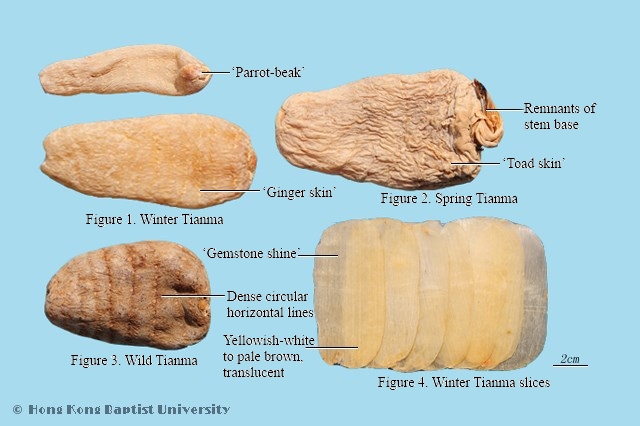|
天麻 Tianma

|
Chinese Name |
天麻 |
|
|
Chinese Pinyin |
Tianma |
|
English Name |
Tall Gastrodiae |
|
Latin Pharmaceutical Name |
Gastrodiae Rhizoma |
|
Category |
Roots and rhizomes |
|
Origin |
The dried tuberous rhizome of Gastrodia elata Bl.(Orchidaceae) |
|
Production Regions |
Primarily produced in the Chinese provinces of Sichuan, Yunnan, Guizhou, Shaanxi, Hubei. |
|
Macroscopic Features |
Oval or long strip-like shape, slightly flat, wrinkled and slightly curved. 3~15cm long, 1.5~6cm wide, 0.5~2cm thick. Externally yellowish-white to pale yellowish-brown, slightly transparent, often has irregular longitudinal wrinkles, with longitudinal wrinkles and potential bud sprouts arranged in numerous wheel-like rings, sometimes can see brown rhizomorph, with spotted scars or membranous scales, which sometimes has brownish-black rhizomorph. Harvested from winter until the stem is withered, the tian ma is called “winter tian ma”, apex has reddish-brown to dark brown top sprout; harvested before the beginning of summer and germination, the tian ma is called “spring tian ma”, apex has remnants of stem base. The entire end has round navel-like scars. Firm texture, hard to break, fractured surface is relatively flat, horn-like, yellowish-white or pale brown. |
|
Quality Requirements |
Superior medicinal material has a firm, heavy textures, the “parrot-beak” feature is present, and there is no hollow core. Tian ma slices shall have firm body, lustrous and transclucent texture. |
|
Properties |
Faint odor, neutral; sweet and slightly acrid. |
|
Functions |
Extinguishes wind, relieves tetany, calms liver, lowbears yang, dispels wind, frees channels. |
|
Technical Terms |
‘Parrot-beak’: this refers to a reddish-brown or deep brown withered bud sprout that remains at the apex of winter tian ma tubers; it is also called ‘red little petal’.
‘Ginger skin’: this refers to distinctive slightly raised sprouts on the outer surface of tian ma medicinal material, which present as discontinuous small spots that are arranged in horizontal circular lines.
‘Toad skin’: this refers to remnants of latent sprouts and longitudinal wrinkles on the surface of tian ma medicinal material, giving the appearance of a toad’s skin, thus it is called so.
‘Gemstone shine’: this generally refers to medicinal material that has a hard texture, a horny fractured surface, and a lustrous shine similar to a gemstone. |
|
Remark |
Cheon-ma (Gastrodia elata) is listed as "Vulnerable" in the International Union for the Conservation of Nature and Natural Resources (IUCN) Red List of Threatened Species. Also, it is listed in the Convention on International Trade in Endangered Species of Wild Fauna and Flora (CITES) Appendix II. Its trade is allowed but subject to licensing controls. |
| Link |
 Medicinal Plant Images Database Medicinal Plant Images Database
 Chinese Medicinal Formula Images Database Chinese Medicinal Formula Images Database
 Chinese Medicine Specimen Database Chinese Medicine Specimen Database
|
|
Permanent URL:https://sys01.lib.hkbu.edu.hk/cmed/mmid/detail.php?pid=B00003 |
|
|

